
A
Better Way to Detect Nuclear Contraband
SNAP and JDEM: Following
the Roadmap to a Strawman
Better Way to Detect Nuclear Contraband
BY LYNN YARRIS
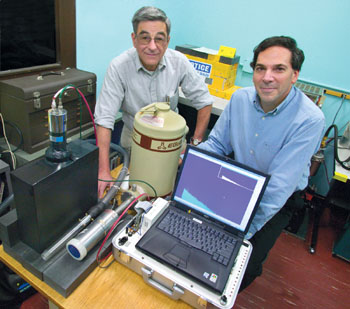 |
|
| Stan Prussin (left) and Rick Norman demonstrated that high-energy gamma-ray emissions can reveal the presence of weapons-grade nuclear materials hidden in cargo containers. |
A new technique that might lead to the quick, accurate and safe detection of nuclear materials being smuggled inside sea-going cargo containers has been demonstrated by a team of researchers with Berkeley Lab, UC Berkeley and Lawrence Livermore National Laboratory (LLNL).
Using Berkeley Lab’s 88-Inch Cyclotron, the researchers showed that irradiating a cargo container’s contents with a beam of neutrons and then measuring the emission of high-energy gamma rays provides a unique identifying signature of plutonium or highly enriched uranium that can be used in weapons of mass destruction.
“A detection system based on our gamma-detection technology has the potential to screen every cargo container entering a United States seaport,” says Eric Norman of the Nuclear Science Division.
Norman and Stanley Prussin, with UC Berkeley’s Nuclear Engineering Department, are co-authors of a paper on this research that will appear in the journal Nuclear Instruments and Methods in Physics Research, along with Ruth-Mary Larimer, Edgardo Brown, Alan Smith, Richard McDonald and Heino Nitsche of Berkeley Lab, Howard Shugart and Puja Gupta of UC Berkeley, and Michael Frank and Thomas Gosnell of LLNL.
Homeland security experts say that terrorist threats are most likely to enter our nation by way of the sea in one of the nearly seven million cargo containers offloaded at U.S. ports every year. These tractor-trailer-sized steel-walled boxes are typically sealed shut in foreign ports and are not opened until delivered by trucks to points across the country. Despite heightened security concerns following the September 11 terrorist attacks, less than two percent of these containers are ever opened and inspected at U.S. seaports, according to the U.S. Customs and Border Protection agency. It is widely agreed that improved technologies for the
nonintrusive inspection of cargo containers are sorely needed. Of greatest concern is the search for so-called special nuclear materials, such as plutonium or uranium 235. Although only mildly radioactive, special nuclear materials in concentrated form can serve as the primary ingredients of nuclear explosives.
“It only takes about 10 kilograms of special nuclear materials to make an atomic bomb, which is about enough material to stuff inside a baseball,” says Norman. “You have to be able to find this when it’s hidden in a container that might be holding nearly 20 metric tons of cargo.”
Whereas x-ray imaging can reveal the presence of an object inside a container that does not conform to a declared manifest, Norman and Prussin say that detecting the emission of high-energy gamma rays gives “a definitive yes or no” as to whether the smuggled object contains special nuclear materials.
 |
|
| At U.S. seaports such as this one in Miami, nearly seven million cargo containers are offloaded each year. As a container may hold about 20 metric tons of goods, it represents a prime target of opportunity for smugglers. | |
Norman and Prussin got their idea while serving as consultants on a project at LLNL. Researchers there were exploring the possibility of bombarding a cargo container with energized neutrons that would trigger a brief fission reaction in plutonium and enriched uranium while not significantly affecting elements such as hydrogen, carbon, oxygen or calcium, which make up food products and other materials commonly shipped by sea. Among the emission products from this fission reaction are “delayed neutrons” — those slowly emitted following an initial burst of released neutrons — which the LLNL researchers were looking to measure.
Norman and Prussin were concerned that a heavy presence of hydrogen in a cargo container would present a severe roadblock to measuring neutron emissions, as hydrogen readily absorbs delayed neutrons.
Says Prussin, “Hydrogen is all over the place in containers. Our thoughts turned to high-energy gamma rays, which can penetrate through hydrogenous materials a heck of a lot better than delayed neutrons can.”
Calculations showed that the relative intensity of delayed high-energy gamma rays is approximately 10 times greater than delayed neutrons, and that gamma rays would get through hydrogenous materials anywhere from 100 to 1,000 times more easily. This means that under some circumstances, gamma rays would be as much as 10,000 times more sensitive a means of detecting special nuclear materials than delayed neutrons.
As a proof-of-principle experiment, Norman, Prussin and their Berkeley and Livermore collaborators generated 8-million-electron-volt beams of neutrons at the 88-Inch Cyclotron, which they moderated and then used to irradiate sample targets of plutonium 239 and uranium 235, plus a variety of materials that might be found in a typical cargo container, such as wood, polyethylene, aluminum
and steel. They then measured gamma ray emissions using both a high-resolution germanium detector and a low-resolution plastic scintillator.
“We found that gamma rays were emitted in a wedge-shaped energy spectrum that is well above any normal background that may be present during the screening process,” Norman says. “We also saw a characteristic half-life decay of approximately 25 seconds. All other materials showed much longer decay times.”
The use of relatively inexpensive plastic scintillators to detect the gamma rays was every bit as effective as the more costly germanium detectors, and helps hold down the cost of a detection system while also speeding up the process.
Based on their tests at the 88-Inch Cyclotron, the collaboration
concluded that with this technology an entire cargo container might
be screened for the presence of special nuclear materials in about
one minute.
SNAP and JDEM: Following the Roadmap to a Strawman
BY PAUL PREUSS
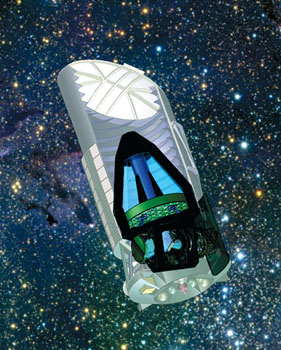 |
|
| A dark-energy mission requires exquisite precision in measurements of distant supernovae, so an optical system like SNAP's, which unifies telescope and detectors in a single instrument, is essential. |
When Supernova/Acceleration Probe (SNAP) reviewers gathered at Berkeley Lab on Nov. 11, on the heels of a two-day SNAP collabor-ation meeting, the long-scheduled session took on unexpected urgency. For in late October, DOE’s Office of Science and NASA’s Office of Space Science announced an agreement on what they called “a roadmap to a strawman” — a plan for a Joint Dark Energy Mission (JDEM) under NASA project management.
“Events have changed what this meeting might have been a month ago,” said Lab Director Charles Shank in his opening remarks. Just the day before, Energy Secretary Spencer Abraham had introduced DOE’s 20-year facilities plan, naming JDEM among the highest research priorities. The plan uses a striking graphic of SNAP to illustrate JDEM, but doesn’t mention SNAP itself.
The bottom line is that JDEM grew from the SNAP concept and is now
open to all competitors. In his charge to the reviewers, SNAP co-principal
investigator and project director Michael Levi said, “We want
you reviewers to help us maximize our bid.”
The process opened with updates on SNAP’s scientific objectives
by principal investigator Saul Perlmutter, mission design by Levi,
and management structure by project manager Henry Heetderks. Their
bare-facts recitations made it clear that SNAP has been ideally conceived
to solve the mysteries of dark energy.
Noting SNAP’s primary “really hard goal” of correlating redshift with changes in dark energy’s equation-of-state parameter, Perlmutter was interrupted by reviewer Steven Battel, who commented that “NASA doesn’t like the term ‘goal’ — they prefer ‘mission objective.’” Perlmutter conceded the need for “jargon translation.”
When Levi detailed the advantages of SNAP’s proposed half-billion-pixel imager, based on revolutionary CCD technology developed at Berkeley Lab, an audience member asked, “who can use our technology? Anybody?” Levi found the prospect of a competitor basing a bid on SNAP’s innovations “bizarre.”
Heetderks, with long experience of NASA, noted that SNAP’s man-agement procedures were congruent with what he termed NASA’s excellent model, and he reassured the audience that “the SNAP team is exceptional and uniquely qualified.” But it will be a challenge to insure that key elements essential to any mission’s success — in particular, that telescope and detector be considered a single instrument — are specified in NASA’s “Announce-ment of Opportunity,” due in October 2005.
At the end of the three-day review Levi remarked that “we had a sharp 14-person review panel that was both supportive and very insightful. We came away with many good suggestions on how to be winners in the upcoming JDEM competition.”
ALS/NCEM Tribute
It was 20 years ago that NCEM first opened its doors to Earth’s most powerful microscopes, and 10 years since the ALS debuted as the largest source of “soft” x-rays and started producing the brightest light in the world. Over those decades, both research centers have achieved international distinction and played critical roles in the study of molecular and submolecular materials.
To honor these milestones, the Lab will dedicate Tuesday to the celebration and recognition of their achievements. See the View’s special anniversary insert in this issue, profiling the two facilities — past, present and future. A schedule of activities for Tuesday is also included.
Making the Lab More Green is a “Team” Effort
BY D. LYN HUNTER
Ken Woolfe cares passionately about the environment, but he’s no eco-freak or recycloholic.
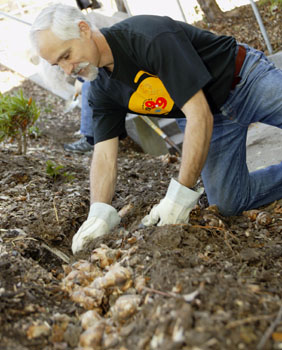 |
|
| Ken Woolfe plants daffodil bulbs near the cafeteria | |
“My approach is low-key,” says Woolfe, an Engineering
Division staffer who provides electronic coordination for the Advanced
Light Source. “The goal is to make things simple and easy, so
folks will want to participate in activities that help preserve nature.”
He carries this philosophy with him to the Lab, where he chairs “The
Green Team,” a 10-year-old group that seeks to improve the environment
on the Hill and surrounding community.
Recently, in an effort to spruce up the landscaping around the cafeteria, Woolfe and a handful of other Green Team members got on their hands and knees to plant nearly 700 daffodil bulbs. Come spring, the blooms will emerge, adding splashes of beautiful color to this popular destination.
“The Lab currently has just three gardeners, and there’s only so much they can do,” explains Woolfe. “The Green Team wanted to help out, knowing that seeing these wonderful flowers will help lift everyone’s spirit.”
The group also organizes an annual beach clean-up at the Berkeley Marina in the spring, as part of Earth Day. But with only $150 of funding each year — generously provided by the Employee Activities Association — these are the only activities the Green Team can afford to sponsor.
As a result, they focus most of their energies on efforts that cost little or no money. The Green Team website is chock full of details on recycling, energy efficiency, and junk mail reduction. And each member works within their own department or building to raise awareness among co-workers about simple steps to “reduce, reuse, and recycle.”
“If every Lab employee does a small amount of work within their own sphere of influence, it really goes a long way towards protecting the environment,” says Woolfe. “It doesn’t take much — just a little thoughtfulness and care.”
He also encourages staff to join the Green Team. Currently, there are more than 100 people on their on e-mail list, but only 10 are active members.
For more information or to join the Green Team, visit the group’s website (see A-Z directory) or contact Woolfe directly.
Short Takes
Trying to Get In? This Trio Holds the Key
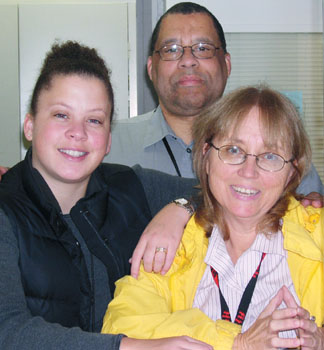 |
|
| (From left): Nikki De Jager, Sam Houston, Valerie Quigley |
Their names may not be recognizable, but Nikki De Jager, Sam Houston, and Valerie Quigley (left) may be among the most important people at the Lab. No one enters the premises — be they employee, student, vendor, or guest — without going through these folks first. That’s because this tiny band of staffers works for the Site Access Office. It’s their job to make sure those who need to get in can. The office has issued ID badges for some 6,000 people who regularly come to the Hill and 4,290 parking passes for those who choose to drive through the gate (even though there are only 2,500 spaces available). The office routinely processes nearly 400 visitor passes per month, but sparks can fly if a guest arrives and they can’t get in. “Every now and then, Lab hosts forget to put their guest’s name on the gate list or to arrange for parking, and it can create some real problems, ” says Quigley, site access supervisor. “We can usually resolve these issues, but to keep everyone happy, we encourage hosts to plan ahead.”
Alert Employee Prevents Spread of Cyber Virus
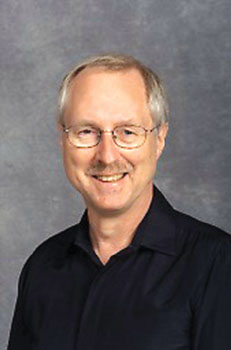 |
|
| Michael O'Keefe | |
When Michael O’Keefe in the Materials Sciences Division recently received an e-mail purporting to include a file of “naughty stuff,” something about the message made him think it was more than just pornographic spam. “It didn’t look right. It was a piece of social engineering that really tried to tempt you into opening something,” O’Keefe said. Thinking it may contain a virus that went undetected by the Lab’s virus wall, O’Keefe forwarded the message and its attachment to the Lab’s Computer Protection Program. They in turn forwarded it to the Lab’s spam-blocking service, which sent it to Trend Micro, vendor of the virus-wall software. They identified the attachment as a new Trojan Horse program, sysbug.A, a covert program that not only steals information from systems, but also paves the way for any hacker to remotely control a machine that has the virus. As a result, Trend Micro made changes in their virus detection and eradication routines. O’Keefe’s quick thinking averted a potential catastrophe, and shows that even a single “heads-up” user can make a big difference.
Nano*High a Hit Among Teachers and Students
It’s hard to believe a group of teachers and students would want to attend school on a Saturday, but more than 200 showed up for the Lab’s first Nano*High session last month to learn about the world of the ultrasmall and how it will affect the future. The visitors filled the Building 66 auditorium to hear Carolyn Bertozzi discuss nanoscience research in the area of proteins and cell surface receptors. Bertozzi used a picture of a soccer player to explain how she and her research team seek solutions to viral infections. Because there was no room for the many parents who also attended, they watched the lecture on a video feed in a nearby conference room. Before Bertozzi took the stage, Mark Alper, deputy director of the Materials Sciences Division, entertained and educated the students through a series of questions and challenges. Following the talk, selected students toured the Nanosciences Laboratory and the Advanced Light Source. The next Nano*High session will take place on Dec. 13.
Director’s Holiday Reception
IDirector Charles Shank invites all employees to attend the Lab's annual holiday party, to be held this year on Tuesday, Dec. 16 from 3 to 4:30 p.m. in the cafeteria. Food and drink will be served, and the Lab’s band will provide musical entertainment. Mark your calendars and come join in the fun.
Shining the Light on a Decade of Great Science
BY LYNN YARRIS
 |
|
When it was first proposed in the early 1980s, under the leadership of then Berkeley Lab director Dave Shirley, skeptics called it “Shirley’s Temple” and questioned the value of a synchrotron optimized for the production of x-ray and ultraviolet light. Today, 10 years after it began operations, with the number of scientists that have made use of its light approaching a thousand, Berkeley Lab’s Advanced Light Source (ALS) has silenced the skeptics and ushered in a golden era for synchrotron radiation research.
“The scientific case for a third generation soft x-ray facility such as the ALS had always been fundamentally sound. However, getting the larger scientific community to believe it was an uphill battle,” says ALS Director Daniel Chemla, a physicist recognized as one of the world’s foremost authorities on the optical and electronic properties of materials, and the man credited with making the ALS one of the nation’s premier scientific user facilities.
“As usual in science, the proof of the pudding is in the eating,” Chemla says. “That’s the only way to counter skepticism. Now that we’ve been generating outstanding science for several years, we’ve established that we’re a world-leading facility in areas of research that only a few years ago some of our ‘friends’ claimed could not be done at the ALS.”
Ground was broken for the ALS in 1988, about three years after the Energy Research Advisory Board recommended its construction to then Secretary of Energy John Herrington. Construction of the ALS was led by project manager Jay Marx, a physicist who had directed the PEP-4 project, one of the largest particle physics experiments of its time.
“We tried to be realistic from the start about how long it would take to build the ALS and how much it would cost,” Marx once told an interviewer. He and his group succeeded magnificently, bringing the ALS project in ahead of schedule by about three days and about $2,000 under its $100 million design and construction budget.
The ALS was commissioned in March of 1993 and the official dedication took place on the morning of Oct. 22, 1993. At that dedication, Lab Director Charles Shank cited six individuals whose contributions were critically important to the project’s completion: Jay Marx, Dave Attwood, Ron Yourd, Alan Jackson, Klaus Halbach, and Klaus Berkner. “We are very proud of all of you,” Shank said.
The early years of the ALS were not without trials and tribulations. Budget crunches, delays in the construction of new beamlines, and organizational difficulties raised concerns. Perhaps the darkest moments came in 1997 following a BESAC review panel of DOE’s synchrotron light sources chaired by Robert Birgeneau of MIT, in which the ALS was made a low priority mainly as a result of user criticisms. In response to that report, Shank elevated the ALS to divisional standing and named Chemla as its new director. In addition, Shank named Neville Smith as deputy for the ALS scientific program and Ben Feinberg deputy for ALS operations.
“Together this management team will provide the leadership necessary for the ALS going into the future,” Shank said at the time. “This is a critically important time in the history of the ALS, and all of us at the Laboratory have much to do to assure its continuing vitality, both scientifically and technologically.”
Under the leadership of Chemla and his management team, the ALS blossomed. In the spring of 2000, the facility underwent a second BESAC review, chaired by Yves Petroff, director general of the European Synchrotron Radiation Facility. This time it passed with flying colors.
“It is clear that the ALS is doing an outstanding job in many areas and that none of the criticisms of the earlier review are still valid,” Petroff declared.
The Petroff panel especially praised Chemla’s efforts to establish a “productive, respectful and direct two-way communication” between ALS management and the facility’s user community.
“The ALS positions Berkeley Lab to be a world leader [as a synchrotron radiation source] for many years to come,” the Petroff panel concluded.
Today, on the site once known as Charter Hill, where Berkeley Lab
founder Ernest O. Lawrence built his famous 184-inch cyclotron, the
ALS stands as a Berkeley landmark and an ongoing scientific success
story. ALS director Chemla recently challenged his management team
to formulate a succinct mission statement. He was pleased with the
result: “Support users in doing outstanding science.”
Twenty Years and Still Growing … Smaller
BY PAUL PREUSS
Sept. 30, 1983 saw the dedication of the National Center for Electron Microscopy and the unveiling of its proudly named Atomic Resolution Microscope. The first instrument able to distinguish atoms in a solid, for 10 years ARM’s 1.6-angstrom imaging resolution was the best of any transmission electron microscope in the world. Housed in a neighboring steel tower was the High-Voltage Electron Microscope, with lower resolution but a highly penetrating, 1.5-million-volt beam, the highest voltage in the U.S.
NCEM’s founder and first scientific director was Gareth Thomas, who arrived at UC Berkeley from Cambridge University in 1960 and later joined the staff of Lawrence Berkeley Laboratory, becoming professor of materials science at UC Berkeley in 1966. Present NCEM Director Uli Dahmen came from Germany in 1974 to be a graduate student in the Thomas group. “What attracted me here was that it was the best place in the world for electron microscopy. It was a time when we were just beginning to explore the possibility of atomic resolution.”
Dahmen, who earned his Ph.D. in 1979, says Thomas knew that the powerful microscopes he envisaged were beyond the capacities of a single university. “User facility” was a new concept to the Department of Energy, but when Thomas pitched his idea to LBL brass, Emilio Segrè asked him, “You mean with HVEMs we could actually see atoms?” Thomas said yes, and Segrè, seconded by another Nobel Prize winner, Luis Alvarez, replied, “Eight million is nothing! We must have such machines.”
In 1976 an LBL-hosted meeting of over 60 electron-microscopy experts envisioned wonders beyond the “critical barrier [2 angstroms], the interatomic distance in solids … We may even be able to study atomic motion directly … What enormous possibilities this concept conjures up.” Enthusiasm was unanimous for a user facility with such extraordinary tools to characterize materials.
By 1980 the fine-grinding mills of government had produced the necessary funds, and it was newly appointed Berkeley Lab principal investigator Ron Gronsky’s first job to see ARM through to conclusion. A machine that would have cost $8 million to build in-house was contracted to the Japan Electron Optics Laboratory (JEOL) for $3 million, and came in on time and under budget two years later. In the interim, says Gronsky, now professor of materials science and engineering at UC Berkeley, “The dollar had strengthened so much against the yen that JEOL owed us money back. Instead, they gave us one of their smaller microscopes.”
A raft of technical challenges — such as one-part-per-million voltage fluctuation and a viewport made of eight-inch-thick leaded glass to shield against x-rays excited by the million-volt beam of electrons hitting a phosphor screen — consumed so much of Gronsky’s time that when he invited his wife to the NCEM dedication ceremony, she said, “That’s like asking me to meet your mistress.”
The only drawback to NCEM’s Berkeley Lab location was California earthquakes. The 30-ton microscope was embedded in a hundred tons of cement to lower its center of gravity, floated on air springs, and tethered to a combination pogo-stick and disk-brake foundation to keep it from walking away in up to a 7.8 magnitude quake.
Crucial to NCEM’s early success was managing director Ken Westmacott. Dahmen says, “Ken Westmacott established the infrastructure that made it an effective user facility and really made the place work.” When they retired in 1991, Thomas and Westmacott’s jobs were combined under acting director Dahmen, whose post was made permanent in 1993.
Some of NCEM’s first instruments have been replaced, including the venerable HVEM, moving to make way for the next-generation TEAM (see story above). NCEM boasts an even-larger arsenal of remarkable machines, including:
- the One Ångstrom Microscope, capable of resolution well below 1 angstrom, imaging atoms as light as carbon and even lithium using unique image-reconstruction software;
- the In-Situ Microscope, whose micromanipulation platforms can tilt, heat, strain, or “nanoindent” samples during real-time observation;
- SPLEEM (Spin-Polarized Low Energy Electron Microscopy) for the study of magnetic materials;
- the U.S.’s first monochromated (narrow beam-energy width) transmission- and scanning-transmission electron microscope; and
- focused ion beams, which shave atom-thick layers off a sample
and can use the emitted ions to construct surface images and combine
them in 3-D.
Although NCEM’s past successes are many, they are just a foretaste of electron microscopy’s potential as the world moves into a new era of nanoscience.
A Tribute to Two Anniversaries
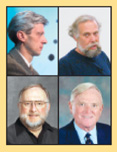 |
|
| Speakers will include (clockwise from upper left): Uli Dahmen, Jay Marx, Gareth Thomas, and Neville Smith. | |
The inaugural event, to be held at noon in the Building 50 auditorium (simulcast to the Building 66 auditorium), will feature speakers from both the Advanced Light Source and the National Center for Electron Microscopy talking about their histories and futures. Among them will be NCEM’s current director, Uli Dahmen; founding scientist and UC Berkeley faculty member Gareth Thomas; nuclear scientist Jay Marx, who was project director for the development of the ALS; and ALS Deputy for Science Neville Smith. Berkeley Lab Deputy Director Pier Oddone will moderate.
Commemorative anniversary cake, punch and magnets will be available
to all attendees. Employees who have never experienced the inside
of either NCEM or the ALS are encouraged to take part in tours of
the two facilities being offered between 1:30 and 3:30 p.m. A Lab
shuttle will pick up passengers every 10 minutes at the cafeteria
bus stop and transport them to both destinations, although pedestrian
traffic is also welcome. Tour groups will assemble in the buildings’
respective lobbies.
Lights, Big Future
BY LYNN YARRIS
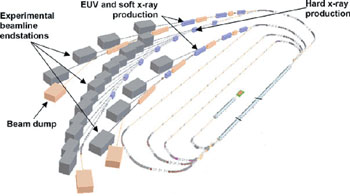 |
|
When the ALS was dedicated in 1993, it was introduced as the nation’s premier scientific source of low-energy, or “soft” x-rays. In the fall of 2001, the ALS underwent a retrofit, replacing three of its conventional storage ring bend magnets with superconducting magnets, or “superbends.” This retrofit, the first ever to take place in an operating synchrotron radiation source, elevated the ALS from being the nation’s premier source of low-energy x-rays to being an important source of high-energy, or “hard” x-rays as well. Future plans call for even more upgrading and the addition of new light-source companions.
The recently-released DOE list of 28 science priorities included the ALS as one of eight far-term projects. Ideally, an ALS upgrade would include the implementation of full energy injection and higher radio-frequency current to increase beam brightness, plus the replacement of aging insertion devices and multipurpose beamlines with the latest in insertion device technology and an array of application-specific beamlines.
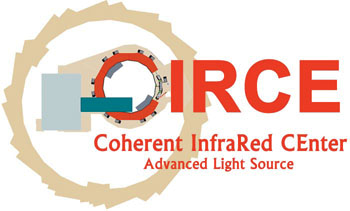 |
|
Says ALS Director Daniel Chemla, “In the coming year, I intend to engage our advisory committees, in particular the Users’ Executive Committee and Scientific Advisory Committee, to flesh out the details and present me with a vision of what the ideal suite of insertion devices and beamlines should look like 10 years from now.”
In a best-case scenario, two additional facilities would be added as complementary companions to the upgraded ALS. The first, called CIRCE for Coherent InfraRed CEnter, would be a small new synchrotron ring, built atop the ALS booster ring, dedicated to generating beams of far-infrared or terahertz-frequency (trillion-cycle-per-second) radiation. These T-rays would be thousands of times more powerful than those obtained from tabletop and even free-electron lasers, making them ideal for a variety of purposes, including the non-destructive imaging of biological and other materials, the manipulation of the electronic properties of semiconductors, medical imaging, and security inspections.
The second proposed facility, which could be adjacent to the ALS, is called LUX, for Linac-based Ultrafast X-ray source. Optimized to produce substantial fluxes of tunable x-rays at pulse lengths ranging from 50 to 200 femtoseconds, LUX could also be capable of generating bursts of x-rays at attosecond pulse lengths. An attosecond is one thousandth of a femtosecond, the timescale of electronic motion (it takes an electron about 24 attoseconds to orbit a hydrogen nucleus). With attosecond x-ray spectroscopy capabilities, it is possible that scientists could steer the motion of electrons and control not only chemical reactions but even the emission of light.
“In our long-range vision,” says Chemla, “the ALS, CIRCE and LUX would become parts of a light-source cluster sharing a common infrastructure.”
With a future this bright, all Berkeley Lab employees might want to have their shades ready.
 |
|
TEAM: Beaming Toward the Bottom
BY PAUL PREUSS
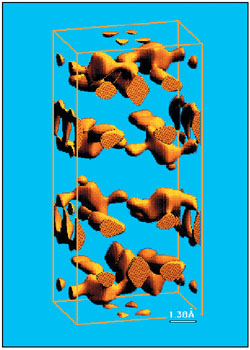 |
|
| This three-dimensional view of the structure of the mineral staurolite, consisting of silicon, aluminum, and oxygen atoms, was made with software that combined separate images. TEAM will be able to view such arrangements of atoms directly, at even higher resolution. | |
In his famous 1959 lecture, “There’s Plenty of Room at the Bottom,” Richard Feynman broached the startling notion that the electron microscope could be improved a hundred times over the 10-angstrom resolution then possible. Since a fraction of an angstrom is much less than the radius of an atom, “it should be possible to see the individual atoms,” Feynman suggested. He meant each atom in a 3-D arrangement of atoms.
Forty-four years later, TEAM, the Transmission Electron Aberration-corrected Microscope, is poised to meet Feynman’s challenge. Led by Uli Dahmen, five facilities supported by DOE’s Office of Basic Energy Sciences — at Argonne, Brookhaven, Oak Ridge, and Lawrence Berkeley National Laboratories, and the University of Illinois — are collaborating to build the first TEAM microscope at NCEM, where the historic High-Voltage Electron Microscope has been dismantled to make room for the new machine.
Electron microscopists have long recognized three ways of improving resolution: high voltage, image reconstruction, and aberration correction. With other improvements, it was high voltage that allowed NCEM’s Atomic Resolution Microscope to break the 2-angstrom barrier in 1983, making columns of atoms visible in crystalline structures; it was image reconstruction that allowed NCEM’s One Ångstrom Microscope to break the 1-angstrom barrier in the 1990s, making columns of light atoms visible even in the presence of their heavy neighbors.
Aberration correction is the final stage of the push to achieve atomic resolution in 3-D. Atoms will be seen not as the tops of columns in a crystal lattice but individually positioned in space — even in glasses with no crystal structure.
Aberrations occur because electron beams spread from the center of the lens or focus at different depths at different electron energies. With optics made of electric and magnetic fields (not glass), correcting aberrations has only recently become feasible.
TEAM’s 0.5-angstrom resolution will mean tighter, brighter beams that penetrate materials more deeply, yielding a stronger signal, higher contrast, and greater sensitivity. TEAM can use thicker samples than the ultrathin foils needed for image reconstruction; there will be more space for samples even than in high-voltage machines.
More space means samples can be manipulated inside the microscope and observed in real time: tilted, heated, bent, dented, bathed in chemicals or electric and magnetic fields. TEAM will be able to examine the properties of structures and defects in 3-D and locate individual dopant atoms in semiconductors. Used for lithography, TEAM’s electron beam can build nanostructures atom by atom.
Moving ahead on schedule, within five years TEAM’s new optics will make Feynman’s atom-scale vision a reality.
Earthquake Survivor
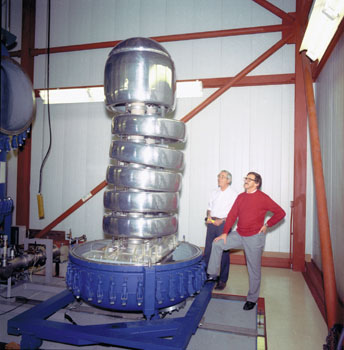 |
|
| This is not a game of quoits, but the damage done to the High Voltage Electron Microscope’s accelerator ring structure when the 1989 Loma Prieta earthquake struck. Minutes earlier researcher Zuzana Liliental-Weber had been working next door at the Atomic Resolution Microscope when she heard a sound and noticed the image shifting on the video screen. She ascribed it to a passing truck. Then the quake hit. She was thrown to the floor and had to crawl away from the swaying column. Returning after the quake, she found that the ARM’s million-volt electron beam was still on; she went back to work — and only left the area when an aftershock shook things up again. This time she took the precaution of manually switching off the beam. | |
Highlights of Great Science
ALS Celebrates Ten Years of Light
BY LYNN YARRIS
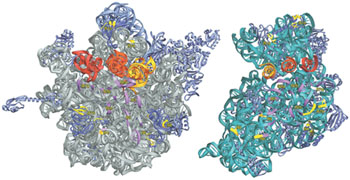 |
|
| Researchers used the light from ALS Beamline 5.0.2 to resolve the crystal structure of the 70S bacterial ribosome to 7.8 angstroms, revealing important details about the two asymmetric subunits, 50S (left) and 30S, which make make up the ribosome. | |
What do ribosomes look like? How small can magnetic storage devices get? Can Moore’s Law continue to be observed? Where do toxic metals go once they’ve contaminated the soil? What’s the best way to keep a baby dry? These are just a tiny sample of the many questions that have been addressed by researchers using Berkeley Lab’s Advanced Light Source. In each case, the unique characteristics of specific ALS beamlines and experimental facilities provided answers that could not have been obtained anywhere else.
For example, a team of researchers led by Harry Noller of UC Santa
Cruz used the protein crystallography facilities at the ALS’
Berkeley Center for Structural Biology to obtain the first-ever high-resolution
look at a ribosome, a virus-sized organelle that is vital to protein
synthesis. The first published ALS images of the ribosome were resolved
to 7.8 angstroms and showed the ribosome to consist of two asymmetric
subunits spanned by an RNA-protein bridge. Subsequent images boast
a resolution of 5.5 angstroms.
The PEEM2 microscope, an ALS spectromicroscopy facility, was used
to produce the first images of the domain structure of an antiferromagnetic
film, a type of material critical to advanced magnetic devices such
as the read heads of computer hard-disk drives. PEEM2 images showed
that the alignments of tiny magnetic domains in lanthanum iron oxide,
each only a few hundred nanometers in size, correspond to a particular
orientation of the material’s crystals.
Gordon Moore’s prediction that the density of circuit elements on microchips will double every 12 to 18 months has held true for the past 30 years. If it is to continue to be the law for computer chips, new fabrication techniques will be needed. At the ALS, a consortium of industry and government labs have constructed the first prototype machine for making computer chips using extreme ultraviolet (EUV) light. Microprocessors based on this technology will operate 10 times faster than today's most powerful chips and are expected to come to market by 2007.
Effective environmental remediation requires basic chemical information at the molecular level about contaminants. Using the Molecular Environmental Science facilities at the ALS, a team of French researchers was able to identify the three main chemical forms taken by zinc-containing compounds in contaminated French and Belgian soils located near decommissioned smelters. This technique holds great promise for future toxic-metal studies.
Disposable baby diapers are a $20 billion-a-year industry, and the search for the perfect bottom sponge has been a driving force in polymer research. Scientists from the Dow Chemical Company used a scanning transmission x-ray microscope at the ALS for a detailed study of “superabsorbent polymers” that are able to soak up lots of liquid. The information obtained was then used to help guide the design of a new superabsorbent polymer fabrication plant.
If these examples have whetted your curiosity, you can read lots more about these and other scientific highlights at the ALS by visiting http://www-als.lbl.gov/als/science/.
Highlights of Great Science
A Few of NCEM's Greatest Hits
BY PAUL PREUSS
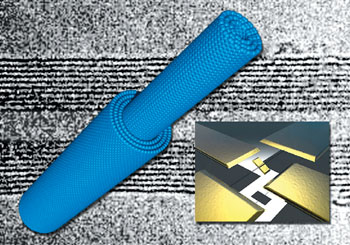 |
|
| Imaged by transmission electron microscopy (background), multiwalled carbon nanotubes form the bearing of the world’s first synthetic nanomotor (inset, Zettl group). | |
Contributions to fundamental science made by NCEM’s staff (presently 15) and users (250 a year) in the last two decades would fill a bookshelf. They include:
- the abstruse — establishing the “critical voltage effect” for determining submicroscopic parameters in alloys
- the practical — tracking the odd distribution of elements in indium gallium nitride, gem of the light-emitting diode industry
- the revolutionary — discovering “magic sizes,” “magic shapes,” and startling behaviors of nanoparticles in alloys, including Brownian motion of melted inclusions in a solid matrix
- the futuristic — imaging telescoping carbon nanotubes, now used as a bearing in the world’s first nanomotor
Plus a few just-plain-intriguing mysteries:
- Uli Dahmen, Ken Westmacott and colleagues from Case Western Reserve
University discovered that a strange “diamond-hexagonal”
form of silicon, reported by Russian investigators, formed from
the intersection of nanoscale
“deformation twins.” “There was hope that a new phase of silicon would have interesting electronic properties,” says Dahmen. “Not this one. Close but no cigar.” - Chuck Echer, who worked with many visitors during his 18 years at NCEM, remembers being able to use “a montage of microscopy techniques to absolutely confirm the presence of interstellar diamonds” in carbonaceous meteorites supplied by NASA Ames Research Center.
- Echer was asked by the curator of UC’s Lowie Museum of Anthropology to date an Egyptian limestone head. Thought to be from 1600 BCE, traces of orpiment (a paint made from a sulfur-arsenic compound) would mean the head was more recent. “I was able to solve this dating problem using the Analytical Electron Microscope,” says Echer, who found no orpiment. “To work on an artifact of that age was a unique forensic investigation into the past.”
For more information on NCEM’s greatest hits, a quick reference is the NCEM website at http://ncem.lbl.gov/frames/research.htm.
Awards
Bissell Named Winner of Komen Research Award
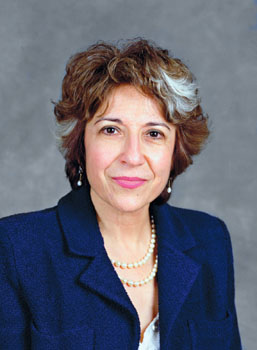 |
|
| Mina Bissell |
Komen awardees are nominated and selected by a panel of their peers. They will be honored at a special dinner during the 26th Annual San Antonio Breast Cancer Symposium, where they will receive a $10,000 honorarium to be applied to their work, a citation, and an inscribed crystal statuette from Tiffany & Co.
“The achievements of each award winner mark significant milestones on the path to eradicating breast cancer as a life-threatening disease,” said Rebecca Garcia, vice president of health sciences for the Foundation.
Bissell’s research examines the sophisticated manner in which the network of physical and biochemical signals converge in an orchestrated manner to affect the signaling that governs gene expression within bodily tissues. She and her colleagues study the factors that lead to cells proliferating, expressing tissue-specific genes or programming themselves for their own death, a phenomenon called apoptosis. In order to understand the intercellular activities and accompanying crosstalk, Bissell and her colleagues have developed unique systems to study gene expression in the context of three-dimensional models representing whole tissues.
Alivisatos Wins “Best of Small Tech”
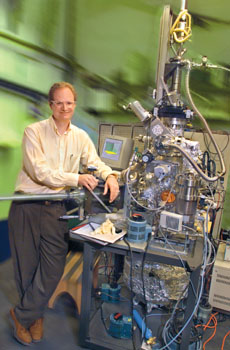 |
|
| Paul Alivisatos | |
Paul Alivisatos of Berkeley Lab, a physical chemist and a pioneering leader in the burgeoning field of nanoscience, won this year’s “Best of Small Tech Researcher Award,” given out by Small Times Magazine. The award, announced on Nov. 10, recognizes the people, products and companies that are leading the growth of the micro and nanotechnology industry.
Alivisatos, who will head Berkeley Lab’s Molecular Foundry,
designed a nanocrystal that is expected to improve the efficiency
of hybrid plastic solar cells.
The award will be presented at the NanoCommerce 2003 conference in
Chicago on Dec. 9.
Flea Market
- AUTOS & SUPPLIES
- ‘00 HONDA CIVIC EX 2 dr coupe, 5-sp man trans, 49K mi,
great cond, new front brakes, silver ext w/dark blue int, moonroof,
CD player, more, $8,500, Don, X6863, (415) 566-2321
‘99 HONDA CRV-EX SUV, 4 wd, bright red, 4 dr, loaded, low mi, ex cond, $14,900, Rob, X5798, 409-1779
‘93 FORD ESCORT WAGON, white, 98K mi, 2 owners, full service history, exc cond, ac, fm/am/cass, well maint, $2,500/bo, Simon, 495-2442 day, (925) 377 0453 eve
‘92 MAZDA MX3, red, 146K mi, 2 dr, 5 sp,very clean, cruise, am/fm/cd, all pwr, ac, sunroof, records, $2,900/bo, Guy, X4703, 482-1777
‘90 TOYOTA TERCEL, 4 dr, silver, CD, ac, good cond, $2,000/bo, Miguel, X4417, 845-0175, mrubio@lbl.gov
‘87 JEEP CHEROKEE PIONEER 4x4, 2 dr, red, pwr win/locks, 5 spd man, all new parts, 270K mi, $2,795, ugly but runs great, Judy, 551-5087
‘85 NISSAN MAXIMA, brown, passed CA smog 11/03, 166K mi, 40K on swapped engine, 30K on overhauled trans & computer, am/fm/CD, new battery, starter, cables, good tires, sunroof, very good paint, leather int, all pwr systems operative except antenna, leather seams are split on seats, $1,500, Glen, X5358, 530-2810 eve
‘65 FORD MUSTANG, 6 cyl, auto, 92K mi, not restored, driven regularly, price neg, Mike, X7838, 654-0929 - HOUSING
- BERKELEY HILLS, house in wooded neighborhood, furn, 3 bdrm/2
bths, lge kitchen, liv rm, din rm, study, priv backyard, avail 3-9/15/04,
$2,100/mo, Gisela, 841-2066
BERKELEY, good size rm, well furn, fast internet access, priv phone line, offstr parking, washing machine, cooking appliance, walking dist to pub trans/Bart/ shops/UC, quiet priv area, tennis court, pool, park, perfer gentleman, no smoker/pet, no guest overnight, $600/mo+fees+internet, fees, deposit $650, roomrenting@hotmail.com, 524-3780
BERKELEY, nr UC, furn 1 brdm apt, hardwd flrs, $1,575 incl PC, DSL & some util, 845-5959, jin.young@juno.com, Paul, X7363
BRIONES, unincorp Martinez, charming small 2 bdrm/1 bth, 2-story cottage w/ character, tile/carpet flrs, high knotty pine celings, part furn, woodsy park setting on small horseranch nr Briones Park, mo-to-mo rent, $1,800/mo + part util & dep, occas pet sitting credit, views, hiking & horse trails nearby, priv gated road, secluded peaceful setting, nr freeways, 20-30 min drive to LBNL, Colette, (925) 370-1292, 6-9 pm or weekends
CENTRAL BERKELEY, 1 bdrm house, walk to campus, $1,100/mo incl utils, 845-5959, jin.young@juno.co, Paul, X7363
CENTRAL BERKELEY, nice furn rms, kitchen, laundry, PC, DSL, hardwd flrs, brkfst, walk to campus/shops, $950/mo, 845-5959, jin.young@juno.com, Paul, X7363
EL CERRITO/KENSINGTON border, inlaw unit: 1 very lrg bdrm & 1 adjacent small bdrm that can be used as an office, windows & sunlight in the lge bdrm, bthrm w/ shower only & kitchenette, nr LBNL & UC, priv entr & access to backyard, nr BART/shops/freeways, peaceful, tree-lined neighborhood w/ schools & playgrounds, nr nature trails, furn w/ essentials, pref mature, responsible, considerate individuals, more than 1 tenant considered for additional cost, avail after 12/15/03, $900/mo+util, Claudia, 334-1960
NORTH BERKELEY HILLS, furn house, 3.5 bdrm/1.5 bths, nr public trans & campus, hardwd flrs, upright piano, deck off bdrm, view, lge secluded garden, gardening service incl, offstr parking, no smoking/ pet, $2,400/mo + $100 cleaning, Dalia, 526-9261
NORTHEAST RICHMOND, avail now, rm for rent & house to share, $500 + 1/2 util or $575/mo incl util, charming home, sunny & clean, will share garage for storage, sunny backyard, old neighborhood, share home w/owner, mature female & her clean cat, nr Arlington Ave, female pref but will consider male, Sheny, 235-2688, shenygiannelli@yahoo.com
RODEO viewpoint home for rent, 3 bdrm/ 2 bths, 2-car garage, fp in family rm, lge backyard w/ bay view, patio & deck, remodeled bthrms, updated kitchen, all appliances, w&d, garden maint incl, nr new elem school, nonsmoker, pets ok, $1,700/mo, avail early 1/04, Helen, X4435, 486-4435, hawheeler@lbl.gov
SOUTH BERKELEY, 1 bdrm refurbished apt, unfurn, 7 unit bldg w/ character, quiet, 15-min walk to campus, nr bus, shopping & park, util incl, $1,100/mo, Kathy, 482-1777, 326-7836, Guy, X4703
HOUSING WANTED- APARTMENT needed for 04/04, visiting professor from Cambridge MA, female, nonsmoking, needs quiet furn apt, inlaw is fine, Marc, 526-7975, mlfischer@lbl.gov
- FREE
- CAT, we are looking for a nice and warm home for Mickey, a very
healthy & sweet cat, Jinghua, 526-3021
VAN SEATS, late model Voyager, quick release bench & bucket, like new, Wayne, X5191, 278-6272
MISC ITEMS FOR SALE
SOFA BED, beige/peach, $100/bo; black metal filing cabinet $30; closet storage organizer, $15; Elfa metal organizer, $75/bo; Clip deluxe surround-sound speakers, exc cond, $400, Susan, SAberg@lbl.gov
GREEN & WHITE GLASS illuminating experiences light fixture, never used, $75 (3/4 of store price), Shirley, 527-6250
HEALTHWAY AIR FILTER 10100, EMF-enhanced media filtration, 12”x12”x22”, 17#, eggplant color, filters to 0.15 microns, cleans 150 sq ft 6x per hr, barely used, was $200/new, $100/bo
KENMORE WASHER & DRYER, lge capacity, 3 yrs old, light use, $160 for both, Steve, 548-9925 after 4:30 pm
SF OPERA TICKETS, balc pair, 2nd row ctr, La Boheme, Sat eve, Jan. 10, $124/pair, Paul, X5508, 526-3519
SILVER TRIANGLE, $10; Wittner metro-nome, $20; make your own music for the holidays, Melissa, 665-5572, leave msg
WHITE WATER KAYAK, Perception make, paddle, helmet, skirt & other accessories, all in exc cond, $400, Chuck, X6503
YAKIMA RACKS FOR VW EUROVAN, used, good cond, bars, towers & clips, 4 bar sets avail, no lock cores but Yakima SKS compatible, single bar $90; 2 bars $150 or all 4 bars for $250, John, X6114, 525-5098
WANTED- BASS PLAYER, join female singer, guitar & banjo, influences:
AK & Union Station, home album, other musicians welcome, Martinez
area, casual & fun, Don, X4224 (12-1pm)
Used Mac G3 300MHz tower or desktop computer, must be demonstrably capable of running Excel 98, Dick, (925) 284-5236
LOST & FOUND- FOUND: Glasses in Perseverance Hall, Giorgio Armani case & prescription glasses, X6765
VACATION- LAKE TAHOE, house, 3 bdrm, 2-1/2 bth, fenced yard, quiet sunny location, skiing nearby, great views of water & mountains, $195/night, 2 night min, Bob (925) 945-9345, nbs@value.net.